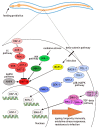Caenorhabditis Elegans and Probiotics Interactions from a Prolongevity Perspective - PubMed (original) (raw)
Review
Caenorhabditis Elegans and Probiotics Interactions from a Prolongevity Perspective
Marianna Roselli et al. Int J Mol Sci. 2019.
Abstract
Probiotics exert beneficial effects on host health through different mechanisms of action, such as production of antimicrobial substances, competition with pathogens, enhancement of host mucosal barrier integrity and immunomodulation. In the context of ageing, which is characterized by several physiological alterations leading to a low grade inflammatory status called inflammageing, evidences suggest a potential prolongevity role of probiotics. Unraveling the mechanisms underlying anti-ageing effects requires the use of simple model systems. To this respect, the nematode Caenorhabditis elegans represents a suitable model organism for the study of both host-microbe interactions and for ageing studies, because of conserved signaling pathways and host defense mechanisms involved in the regulation of its lifespan. Therefore, this review analyses the impact of probiotics on C. elegans age-related parameters, with particular emphasis on oxidative stress, immunity, inflammation and protection from pathogen infections. The picture emerging from our analysis highlights that several probiotic strains are able to exert anti-ageing effects in nematodes by acting on common molecular pathways, such as insulin/insulin-like growth factor-1 (IIS) and p38 mitogen-activated protein kinase (p38 MAPK). In this perspective, C. elegans appears to be advantageous for shedding light on key mechanisms involved in host prolongevity in response to probiotics supplementation.
Keywords: ageing; immunosenescence; lifespan; nematode; oxidative stress; pathogen protection; probiotic bacteria.
Conflict of interest statement
The authors declare no conflicts of interest.
Figures
Figure 1
Micrograph representing the model organism Caenorhabditis elegans (the head is on the left; the tail is on the right). The principal biomarkers and physiological traits associated with ageing are described in the squares. Magnification: 5×.
Figure 2
Schematic representation of the most common signaling pathways influenced by probiotic strains employed in C. elegans studies. Each pathway is represented by a distinct color gradient. The list of single bacterial strains influencing the different pathways is reported in Table 1. Abbreviations used: AMPK: 5′ AMP-activated protein kinase; AKT-1/2: serine/threonine protein kinase orthologs; BAR-1: beta-catenin/armadillo Related-1; DAF: dauer formation; DBL-1: DPP/BMP-Like-1; HSF-1: heat-shock transcription factor-1; IIS: insulin/insulin-like growth factor-1; JKK-1: c-Jun N-terminal kinase kinase; JNK-1: c-Jun N-terminal kinase; MAPK: mitogen-activated protein kinase; NSY-1: neuronal symmetry-1; PDK-1: phosphoinositide-dependent kinase 1; PMK-1: p38 mitogen-activated protein kinase-1 ortholog; RACK-1: receptor activated protein C kinase; SEK-1: SAPK/ERK kinase-1; SGK-1: serine/threonine protein kinase ortholog; SKN-1: skinhead family member-1; SMA: small; TIR-1: toll interleukin-1 receptor-1.
Similar articles
- Influence of oral supplementation with sesamin on longevity of Caenorhabditis elegans and the host defense.
Yaguchi Y, Komura T, Kashima N, Tamura M, Kage-Nakadai E, Saeki S, Terao K, Nishikawa Y. Yaguchi Y, et al. Eur J Nutr. 2014 Dec;53(8):1659-68. doi: 10.1007/s00394-014-0671-6. Epub 2014 Feb 19. Eur J Nutr. 2014. PMID: 24549958 - Cell Signaling of Caenorhabditis elegans in Response to Enterotoxigenic Escherichia coli Infection and Lactobacillus zeae Protection.
Zhou M, Liu X, Yu H, Yin X, Nie SP, Xie MY, Chen W, Gong J. Zhou M, et al. Front Immunol. 2018 Sep 10;9:1745. doi: 10.3389/fimmu.2018.01745. eCollection 2018. Front Immunol. 2018. PMID: 30250464 Free PMC article. - Significance of probiotics in remodeling the gut consortium to enhance the immunity of Caenorhabditis elegans.
Udayakumar P, Das R, Kannadasan A. Udayakumar P, et al. Genesis. 2021 Dec;59(12):e23454. doi: 10.1002/dvg.23454. Epub 2021 Oct 18. Genesis. 2021. PMID: 34664387 Review. - Commensals, probiotics and pathogens in the Caenorhabditis elegans model.
Clark LC, Hodgkin J. Clark LC, et al. Cell Microbiol. 2014 Jan;16(1):27-38. doi: 10.1111/cmi.12234. Epub 2013 Nov 15. Cell Microbiol. 2014. PMID: 24168639 Review.
Cited by
- A Mechanistic Study of the Antiaging Effect of Raw-Milk Cheese Extracts.
Cardin G, Poupet C, Bonnet M, Veisseire P, Ripoche I, Chalard P, Chauder A, Saunier E, Priam J, Bornes S, Rios L. Cardin G, et al. Nutrients. 2021 Mar 10;13(3):897. doi: 10.3390/nu13030897. Nutrients. 2021. PMID: 33802038 Free PMC article. - Heat-Treated Bifidobacterium longum CECT-7347: A Whole-Cell Postbiotic with Antioxidant, Anti-Inflammatory, and Gut-Barrier Protection Properties.
Martorell P, Alvarez B, Llopis S, Navarro V, Ortiz P, Gonzalez N, Balaguer F, Rojas A, Chenoll E, Ramón D, Tortajada M. Martorell P, et al. Antioxidants (Basel). 2021 Mar 30;10(4):536. doi: 10.3390/antiox10040536. Antioxidants (Basel). 2021. PMID: 33808122 Free PMC article. - Probiotics Interactions and the Modulation of Major Signalling Pathways in Host Model Organism Caenorhabditis elegans.
Mahesh R, Ilangovan P, Nongbri D, Suchiang K. Mahesh R, et al. Indian J Microbiol. 2021 Dec;61(4):404-416. doi: 10.1007/s12088-021-00961-3. Epub 2021 Jul 1. Indian J Microbiol. 2021. PMID: 34744196 Free PMC article. Review. - Lactobacillus paracasei HII01 enhances lifespan and promotes neuroprotection in Caenorhabditis elegans.
Kumaree KK, Prasanth MI, Sivamaruthi BS, Kesika P, Tencomnao T, Chaiyasut C, Prasansuklab A. Kumaree KK, et al. Sci Rep. 2023 Oct 4;13(1):16707. doi: 10.1038/s41598-023-43846-9. Sci Rep. 2023. PMID: 37794096 Free PMC article. - Potential probiotic Lactiplantibacillus plantarum DS1800 extends lifespan and enhances stress resistance in Caenorhabditis elegans model.
Kim S, Lee YR, Yang H, Park CH, Yun CS, Jang BC, Hong Y, Park DS. Kim S, et al. Front Physiol. 2024 Oct 22;15:1476096. doi: 10.3389/fphys.2024.1476096. eCollection 2024. Front Physiol. 2024. PMID: 39502409 Free PMC article.
References
Publication types
MeSH terms
Substances
LinkOut - more resources
Full Text Sources
Other Literature Sources

